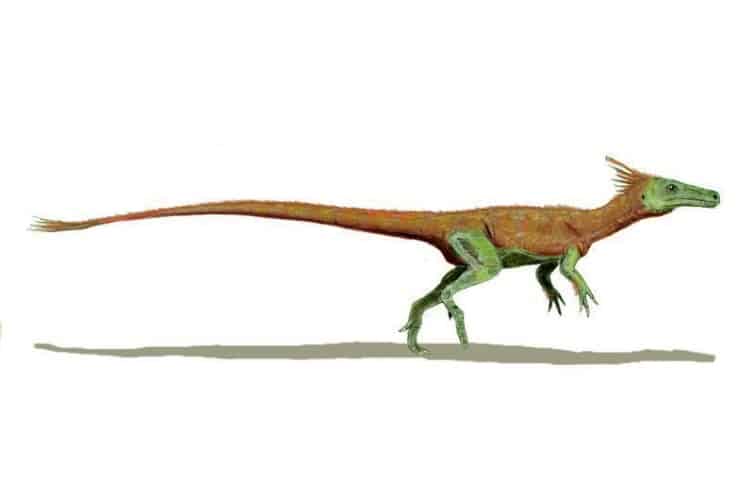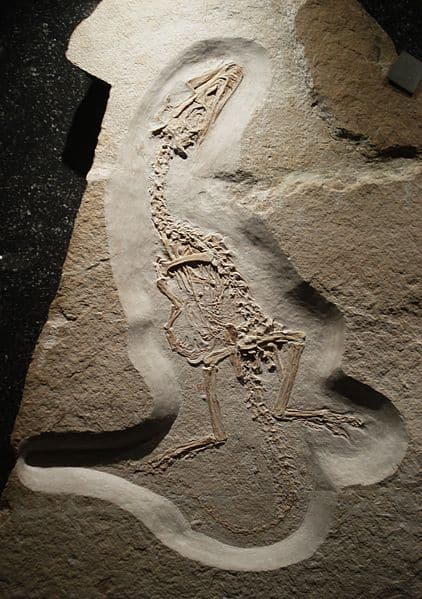Juravenator, whose remains were unearthed in the Franconian Jura of Germany, offers a fascinating glimpse into the past. Its discovery has provided paleontologists with precious insights into the diversity of theropod dinosaurs. As we delve into the world of this intriguing predator, we’ll uncover the key facts that piece together its existence and the environment it once dominated.
Juravenator Key Facts
| Keyword | Fact |
|---|---|
| Pronunciation | ju-rah-ve-nay-tor |
| Meaning of name | Jura Mountains Hunter |
| Group | Theropoda |
| Type Species | Juravenator starki |
| Diet | Carnivore |
| When it Lived | 157.3 to 152.1 MYA |
| Period | Late Jurassic |
| Epoch | Kimmeridgian |
| Length | 2.5 feet |
| Height | Around 1 foot |
| Weight | Around 1 pound |
| Mobility | Moved on two legs |
| First Discovery | 1998 by Klaus-Dieter Weiß and Hans-Joachim Weiß |
| Location of first find | Franconian Jura, Germany |
| First Described by | 2006 by Ursula Göhlich and Luis Chiappe |
| Holotype | JME Sch 200 |
Juravenator Origins, Taxonomy and Timeline
The tale of Juravenator, which translates to “hunter of the Jura Mountains,” begins with its name, a nod to the region where it was first discovered. The etymology stems from the majestic Jura Mountains coupled with the Latin word ‘venator’, meaning hunter. The type species in focus here is Juravenator starki, and refers to the owner of the quarry where the specimen was found.

Delving into its taxonomic classification, Juravenator is a member of the Theropoda, specifically within the Compsognathidae (Theropoda: Coelurosauria). This places it close to the infamous Compsognathus.
The timeline of this fascinating creature spans the Late Jurassic Period, specifically the Late Kimmeridgian Epoch. It roamed our planet approximately 155.7 to 150.8 million years ago, a time when the Earth was teeming with life and dinosaurs were the dominant terrestrial vertebrates.
Discovery & Fossil Evidence
The discovery of Juravenator starki is a tale of patience and serendipity. It was during a paleontological expedition in the summer of 1998, organized by the Jura-Museum Eichstätt, that volunteers Klaus-Dieter Weiß and his brother Hans-Joachim Weiß unearthed a chalk plate with visible vertebrate remains in the Quarry Stark. Initial preparations revealed the head of a small theropod, but the process was halted due to the delicate nature of the bones and the challenging matrix surrounding them. A CT scan initially suggested that only a partial skeleton existed, leading to a temporary discontinuation of the preparation.
 Fossil of juravenator
Fossil of juravenator Fossil of Juravenator starki, a theropod dinosaur that lived in the Solnhofen archipelago 150 million years ago
Fossil of Juravenator starki, a theropod dinosaur that lived in the Solnhofen archipelago 150 million years ago
The narrative took a turn in 2003 when Martina Kölbl-Ebert, the new museum director, decided to resume work on the fossil. Preparator Pino Völkl dedicated seven hundred meticulous hours to reveal that, contrary to earlier beliefs, almost the entire skeleton was intact. This discovery was not just a complete articulated skeleton with skull of a juvenile individual but also included rare impressions of soft parts, making it one of the most complete non-avian theropod specimens ever found in Europe.
In 2006, the findings culminated in the naming and description of the type species Juravenator starki by Ursula Göhlich and Luis Chiappe. The name pays homage to the Jura Mountains and the Latin term for hunter, ‘venator’, as well as honoring the Stark family, the quarry owners. The holotype, JME Sch 200, was located in a marl layer dating back approximately 151.0 to 152.0 million years, and its discovery has significantly enriched our understanding of European dinosaurs from the Late Jurassic period.
Juravenator Size and Description
Juravenator was a small, nimble hunter that walked on two legs, known for its agility and potential speed. Its physical build was streamlined, with a set of unique features that hint at a life adapted to quick pursuits and efficient hunting. The teeth at the front of its snout were finely serrated, ideal for gripping onto prey. Furthermore, its arms ended in sharp claws, suggesting a predator well-equipped for a carnivorous diet.
The fossil evidence points to a creature with a relatively short upper arm bone and a long, slender tail, which would have aided in balance and swift movement. Its overall anatomy suggests that Juravenator was a compact and efficient little hunter that could navigate its environment with ease.
Size and Weight of Type Species
The holotype and only specimen, unfortunately likely a juvenile, measured a mere 75.0 cm in length. While this gives us a glimpse into the size of a young Juravenator, the adult size remains speculative. However, the proportions and traits observed suggest that even fully grown individuals were likely on the smaller end of the theropod size spectrum. This size would have facilitated a lifestyle that required quick, nimble movements, possibly for chasing down prey or navigating through dense vegetation.
The Dinosaur in Detail
Juravenator’s integumentary features offer a fascinating blend of traditional dinosaur scales and potential feather-like structures. Initially classified within the Compsognathidae family. It was considered a relative of both Compsognathus, known for its scaly tail, and feathered dinosaurs like Sinosauropteryx. The skin patch found on Juravenator’s tail and lower hind leg predominantly shows scales but also hints at simple feathers, suggesting a complex evolutionary relationship between scales and feathers in Theropods.
Emerging research, including a 2020 study, sheds light on intriguing aspects of Juravenator’s behavior and sensory capabilities. The structure of its scleral rings suggests that it may have been nocturnal. This trait could also be linked to its juvenile status.
Moreover, the discovery of small, round structures on the sides of its tail, akin to integumentary sense organs found in crocodiles, hints at a sensory adaptation for detecting movement in water. This could imply that Juravenator had a partially aquatic hunting strategy, using these sensory organs to track aquatic prey—a remarkable insight into the diverse survival strategies of Theropods.
Interesting Points about Juravenator
- Juravenator’s fossils were found with evidence of skin and scales. This is a rare find and provides invaluable insight into the appearance and texture of its integument.
- Despite being a carnivore, Juravenator’s teeth were less serrated than those of other Theropods, suggesting a diet that may have included a variety of prey.
- The discovery of Juravenator has challenged previous notions about the diversity and distribution of small Theropods in the Late Jurassic Period.
- The preservation of Juravenator’s holotype is so exceptional that it includes remnants of soft tissue, offering a rare opportunity to study the biology of dinosaurs beyond just their hard bones.
- The region where Juravenator was found is a significant paleontological site. Fossils of both Compsognathus and Archeopteryx have been found there. Further contributing to our understanding of Jurassic European dinosaur fauna.
Juravenator in its Natural Habitat
Imagine the lush landscapes of the Late Jurassic Period, a time when the Earth was warm and teeming with life. Juravenator thrived in this environment, navigating through dense vegetation and utilizing its keen senses to hunt. The climate was subtropical, with ample rainfall supporting a diverse array of plant life, from towering conifers to ferns and cycads. It is possible that Juravenator was a nocturnal animal.
As a carnivore, Juravenator was an active participant in the food web, preying on smaller animals and perhaps scavenging when the opportunity arose. Its bipedal locomotion suggests a lifestyle of a pursuer, capable of rapid movements to catch its prey. While we can only speculate on its life expectancy and social behavior, the solitary nature of many theropods could suggest that Juravenator was a lone hunter, relying on stealth and agility rather than the strength of numbers.
Contemporary Dinosaurs
Imagine the green landscapes of Late Jurassic Europe. It was a time when the ground trembled under the weight of giants. At the heart of this jurassic drama was Juravenator, a sprightly little carnivore, no larger than a modern-day turkey. Its sleek, lithe body weaved through the underbrush. A shadow among giants, always on the lookout for a meal or an opportunity.
True titan of the time, Europasaurus towered over Juravenator. Europasaurus, although the smaller cousin of the Brachiosaurus, could still shake the earth with its steps. It was indeed larger than a double-decker bus. These behemoths likely paid no mind to the tiny Juravenator. They would be too busy with their own high-browsing feasts to notice the minuscule menace. Yet, the fallen leaves from their feasting, or perhaps the carcasses left behind from a less fortunate day, could provide a scavenging opportunity for our sharp-toothed protagonist.
In this ancient world, Juravenator had to be both hunter and hunted, navigating a complex web of relationships. It might have spent its days dodging the heavy feet of Europasaurus, a creature so immense it could be mistaken for a moving hillside. The competition for resources was fierce, and every day was a lesson in survival.
Frequently Asked Questions
The brothers Klaus-Dieter, and Hans-Joachim Weiß discovered it in 1998.
The name translates to “hunter of the Jura Mountains,” reflecting both its predatory nature and the location of its discovery.
This creature is a theropod, specifically within the Coelurosauria.
This dinosaur roamed the Earth during the Late Jurassic Period, around 157.3 to 152.1 million years ago.
As a carnivore, its diet likely consisted of smaller animals and possibly included scavenging.
Sources
The information in this article is based on various sources, drawing on scientific research, fossil evidence, and expert analysis. The aim is to provide a comprehensive and accurate overview of Juravenator. However, our understanding of dinosaurs and their world is constantly evolving as new discoveries are made.
Article last fact-checked: Joey Arboleda, 11-04-2023
Featured Image Credit: Nobu Tamura, CC BY-SA 3.0, via Wikimedia Commons

